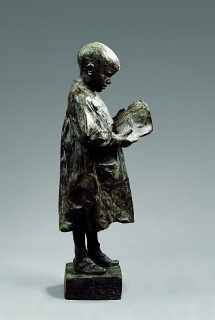|
|
| |
|
|
| |
Artisti / Artists : Museo Vito
Mele |
|
|
| |
 |
Vincenzo Gemito |
|
|
|
Adottato da un artigiano, nasce a Napoli nel
1852. Nel 1861 entra nella bottega dello scultore
Emanuele Caggiano, dove incomincia a disegnare
copiando i modelli del maestro. Dal 1862, con
il pittore e amico Antonio Mancini, frequenta
lo studio di Stanislao Lista dove impara a maneggiare
la creta e la cera, accostandosi sempre di più
ai soggetti tratti dalla realtà. Nel 1868
espone per la prima volta: partecipa, infatti,
al concorso annuale promosso dall’Istituto
di BelleArti di Napoli, presentando la scultura
di Bruto;
contemporaneamente espone alla Promotrice di Belle
Arti il Giocatore, opera acquistata da Vittorio
Emanuele II per la Reggia di Capodimonte. Già
in questa scultura si avverte l’esigenza
dell’artista di superare gli stilemi del
verismo sociale, in favore di una maggiore sintesi
espressiva di realtà e storia. Di questo
periodo sono anche i ritratti di Verdi, Michetti
(presentato al Salon di Parigi del 1876) e Morelli.
Nel 1876 conosce il pittore spagnolo Mariano Fortuny
che lo introduce nell’ambiente artistico
parigino, soprattutto con il pittore Meissonier
che lo ospita nella capitale francese sino al
1879. Qui l’artista napoletano si interessa
principalmente della scultura di Dubois e Carpeaux;
ed espone al Salon del 1877 la famosa scultura
del Pescatoriello, oggi al Museo del Bargello
a Firenze. Rientrato a Napoli nel 1880, esegue
alcune copie da sculture antiche conservate al
Museo Nazionale; nel 1881 realizza L’acquaiolo,
lavoro che testimonia chiaramente il gusto neo-ellenico
dello scultore. Nel 1886 inizia la grande statua
di Carlo
V da collocare in una nicchia del Palazzo Reale
di Napoli. Questo è il periodo più
buio dell’artista, segnato da una grave malattia
psichica che lo porta ad annullare, quasi totalmente,
per circa diciotto anni, ogni tipo di rapporto
col mondo esterno. In questi anni si dedica prettamente
all’attività grafica, realizzando
poche opere scultoree, comunque continua ad esporre
al Salon di Parigi del 1889 e del 1900.
Tema dominante dell’opera del maestro negli
ultimi anni è la raffigurazione di Alessandro
Magno, personaggio inteso da Gemito come incarnazione
di tutte le virtù. Dal 1920 è per
un lungo periodo a Roma, e nel 1924 si reca per
l’ultima volta a Parigi. Muore a Napoli nel
1929.
|

BIMBO
CHE LEGGE, s.d. (undated)
bronzo, h. cm. 58
|
|
|
|
| |
|
|
| |
|
 |
Vincenzo Gemito |
|
|
Vincenzo Gemito, born in Naples in 1852,
was adopted by an artisan. In 1861 he joined the
studio of the sculptor Emanuele Caggiano and began
to draw, copying the maestro’s models. The
following year, with friend and painter Antonio
Mancini, he went to Stanislao Lista’s studio
to learn to work clay and wax, moving closer to
subjects drawn from real life. He exhibited for
the first time in 1868, taking part in the annual
competition promoted by the Naples Istituto di
Belle Arti with the sculpture Bruto. The Giocatore,
a work acquired by Vittorio Emanuele II for the
Palace of Capodimonte, was on show at the same
time at the Promotrice di Belle Arti. Already
evident in this sculpture was Gemito’s need
to go beyond the
stylistic mannerisms of social realism to attain
a more expressive synthesis of reality and history.
His portraits of Verdi and Michetti were shown
at the Paris Salon in 1876. The Spanish painter
Mariano Fortuny introduced him to the Paris art
world and he was a guest of the painter Meissonier
until 1879. Here the artist’s chief interest
was in the work of the sculptors Dubois and Carpeaux.
At the 1877 Salon he exhibited the famous sculpture
Pescatoriello, now in the Museo del Bargello,
Florence.
He returned to Naples in 1880 where he made several
copies of classical sculptures from the Museo
Nazionale. The next year he made L’Acquaiolo,
a work which testifies to his neo-Hellenic taste.
In 1886 he began the statue of Carlo V which is
housed in the royal palace at Naples. This is
the artist’s darkest period, marked by serious
mental illness which induced him to cancel almost
all contact with the outside world for 18 years.
During this time he devoted himself mainly to
graphics. Though he made few sculptures, he did
exhibit at the Paris Salon in 1889 and in 1900.
The portrayal of Alexander the Great, regarded
by Gemito as the personification of virtue, is
the central theme dominating the last years of
the artist’s work. He paid his last visit
to Paris in 1924 and died in Naples five years
later.
.
|
|
|
|
|
|
 |





